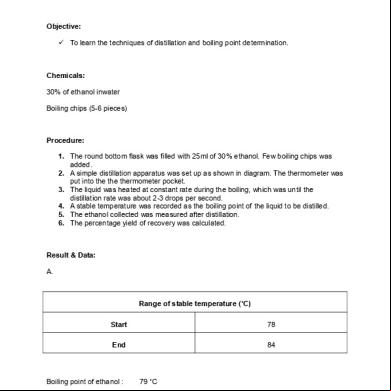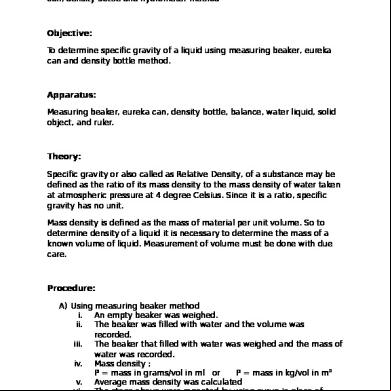Lab Experiment Uv Spectroscopy 402p6j
This document was ed by and they confirmed that they have the permission to share it. If you are author or own the copyright of this book, please report to us by using this report form. Report 445h4w
Overview 1s532p
& View Lab Experiment Uv Spectroscopy as PDF for free.
More details 6h715l
- Words: 611
- Pages: 4
Experiment Ultra-Violet Spectroscopy (UV)
Introduction Ultraviolet-visible (UV-vis) spectroscopy is used to obtain the absorbance spectra of a compound in solution or as a solid. What is actually being observed spectroscopically is the absorbance of light energy or electromagnetic radiation, which excites electrons from the ground state to the first singlet excited state of the compound or material. The UV-vis region of energy for the electromagnetic spectrum covers 1.5 6.2 eV which relates to a wavelength range of 800 - 200 nm. The Beer-Lambert Law, Equation 1, is the principle behind absorbance spectroscopy. For a single wavelength, A is absorbance, ε is the molar absorptivity of the compound or molecule in solution (M-1cm-1), b is the path length of the cuvette or sample holder, and c is the concentration of the solution (M).
There are three types of absorbance instruments used to collect UV-vis spectra which are single beam spectrometer, double beam spectrometer and simultaneous spectrometer. All of these instruments have a light source, a sample holder and a detector, but some have a filter for selecting one wavelength at a time. The single beam instrument has a filter or a monochromator between the source and the sample to analyze one wavelength at a time. The double beam instrument has a single source and a monochromator and then there is a splitter and a series of mirrors to
get the beam to a reference sample and the sample to be analyzed, this allows for more accurate readings. In contrast, the simultaneous instrument does not have a monochromator between the sample and the source; instead, it has a diode array detector that allows the instrument to simultaneously detect the absorbance at all wavelengths. The simultaneous instrument is usually much faster and more efficient, but all of these types of spectrometers work well.
Objective To determine the amount of caffeine in the soft drink sample.
Procedure A Preparation of Standard solution 1. 250 mg of caffeine was poured into 250 ml volumetric flask and diluted to mark with distilled water to make 1000 ppm stock solution. 2. A series of concentration was prepared by diluting 12.5 ml, 10 ml, 7.5 ml, 5 ml and 2.5 ml by using a burette into 50 ml volumetric flask. The solution was diluted to mark with distilled water. B Caffeine extraction 1. 50 ml of aliquot was took from the standard solution and placed in separating funnel. 2. 25 ml of dichloromethane was added into the funnel. 3. The mixture was shook until the caffeine standard was fully extracted.
C Sample preparation 1. 10 ml of soft drinks (chrysanthemum tea) was put into the beaker and ready to measure the absorabnce.
Discussion In this experiment, Caffeine is a stimulant that is commonly found in many foods and drinks that we consume. Caffeine is a common organic molecule found in many beverages such as coffee, tea and cola. Like many conjugated organic molecules, caffeine absorbs radiation with a wavelength around 260 nm. Caffeine in beverages such as chrysanthemum tea was analyzed and determined by using UV-Vis spectroscopy. A series of standard caffeine were prepared which concentration are 0.5, 1.5, 2.5, 3.5 and 4.5 mg/L respectively. The readings of the absorbance for each of the concentration are as the following, 0.0864, 0.2152, 0.4591, 0.6367 and 0.8044. The correlation coefficient of the caffeine standard is 0.99953. The readings of the absorbance of the samples are 2.5432, 2.5385 and 2.5572. The average reading of the samples is 2.5463.
Conclusion The average reading of caffeine in the sample of Chrysanthemum tea is 2.5463.
References Trigilia
L.
(2010).
Analysis
of
Caffeine
in
Soft
Drink.
Retrieved
from
http://www.livestrong.com/article/121520-analysis-caffeine-soft-drinks/ Wikipedia
(n.d.).
Ultraviolet-visible
Spectroscopy.
Retrieved
http://en.wikipedia.org/wiki/Ultraviolet%E2%80%93visible_spectroscopy
from
Introduction Ultraviolet-visible (UV-vis) spectroscopy is used to obtain the absorbance spectra of a compound in solution or as a solid. What is actually being observed spectroscopically is the absorbance of light energy or electromagnetic radiation, which excites electrons from the ground state to the first singlet excited state of the compound or material. The UV-vis region of energy for the electromagnetic spectrum covers 1.5 6.2 eV which relates to a wavelength range of 800 - 200 nm. The Beer-Lambert Law, Equation 1, is the principle behind absorbance spectroscopy. For a single wavelength, A is absorbance, ε is the molar absorptivity of the compound or molecule in solution (M-1cm-1), b is the path length of the cuvette or sample holder, and c is the concentration of the solution (M).
There are three types of absorbance instruments used to collect UV-vis spectra which are single beam spectrometer, double beam spectrometer and simultaneous spectrometer. All of these instruments have a light source, a sample holder and a detector, but some have a filter for selecting one wavelength at a time. The single beam instrument has a filter or a monochromator between the source and the sample to analyze one wavelength at a time. The double beam instrument has a single source and a monochromator and then there is a splitter and a series of mirrors to
get the beam to a reference sample and the sample to be analyzed, this allows for more accurate readings. In contrast, the simultaneous instrument does not have a monochromator between the sample and the source; instead, it has a diode array detector that allows the instrument to simultaneously detect the absorbance at all wavelengths. The simultaneous instrument is usually much faster and more efficient, but all of these types of spectrometers work well.
Objective To determine the amount of caffeine in the soft drink sample.
Procedure A Preparation of Standard solution 1. 250 mg of caffeine was poured into 250 ml volumetric flask and diluted to mark with distilled water to make 1000 ppm stock solution. 2. A series of concentration was prepared by diluting 12.5 ml, 10 ml, 7.5 ml, 5 ml and 2.5 ml by using a burette into 50 ml volumetric flask. The solution was diluted to mark with distilled water. B Caffeine extraction 1. 50 ml of aliquot was took from the standard solution and placed in separating funnel. 2. 25 ml of dichloromethane was added into the funnel. 3. The mixture was shook until the caffeine standard was fully extracted.
C Sample preparation 1. 10 ml of soft drinks (chrysanthemum tea) was put into the beaker and ready to measure the absorabnce.
Discussion In this experiment, Caffeine is a stimulant that is commonly found in many foods and drinks that we consume. Caffeine is a common organic molecule found in many beverages such as coffee, tea and cola. Like many conjugated organic molecules, caffeine absorbs radiation with a wavelength around 260 nm. Caffeine in beverages such as chrysanthemum tea was analyzed and determined by using UV-Vis spectroscopy. A series of standard caffeine were prepared which concentration are 0.5, 1.5, 2.5, 3.5 and 4.5 mg/L respectively. The readings of the absorbance for each of the concentration are as the following, 0.0864, 0.2152, 0.4591, 0.6367 and 0.8044. The correlation coefficient of the caffeine standard is 0.99953. The readings of the absorbance of the samples are 2.5432, 2.5385 and 2.5572. The average reading of the samples is 2.5463.
Conclusion The average reading of caffeine in the sample of Chrysanthemum tea is 2.5463.
References Trigilia
L.
(2010).
Analysis
of
Caffeine
in
Soft
Drink.
Retrieved
from
http://www.livestrong.com/article/121520-analysis-caffeine-soft-drinks/ Wikipedia
(n.d.).
Ultraviolet-visible
Spectroscopy.
Retrieved
http://en.wikipedia.org/wiki/Ultraviolet%E2%80%93visible_spectroscopy
from










